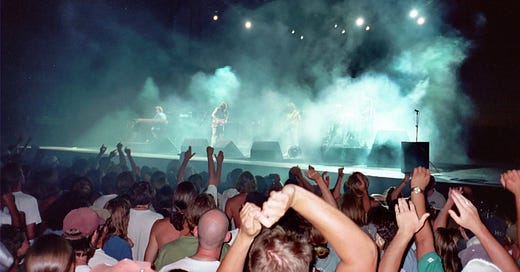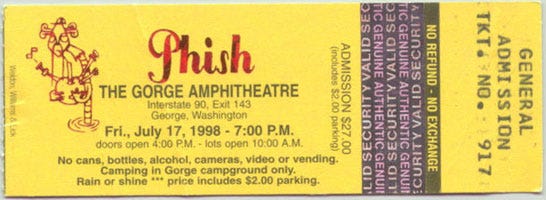
SET 1: Makisupa Policeman > Ya Mar, Gumbo, Divided Sky, Waste > My Mind's Got a Mind of its Own, My Soul
SET 2: Also Sprach Zarathustra > Mike's Song > Weekapaug Groove > Character Zero
ENCORE: Punch You in the Eye > Rocky Top
Knowing that I’d be tackling these shows on the newsletter soon, I held off listening to the new The Gorge ‘98 boxset for six months, until just now. And I’m happy to confirm that the featured three-song sequence of this show remains one of my favorite stretches of Phish ever. The soundboard clarity brings out previously unheard dimensions of detail in these three songs, capturing all that Phish could achieve in the post-transformation heights of 1998 and the incredible versatility of their talents at this point in history. We’re so blessed to finally have an official release of Waste > MMGAMOIO > My Soul.
OK, can’t keep that up for more than a paragraph (but it’s true that even the Waste and My Soul solos are shockingly good in this show). Nope, we’re here to talk about the 2001 > Mike’s > Weekapaug, an hour of music that can hang with anything from the previous fall or any year, in my personal assessment. It’s everything I want from Phish: magically telepathic, so fun and accessible on the surface but full of texture and depth in headphones, and uncompromising in its patience and determination to see each idea to its completion.
It’s the performance I referred to the other day when I said that the band’s mission statement didn’t emerge until night 3. Here, in full display, are all the characteristics that define Phish’s highest improvisational peaks in 1998 – ideas that emerged in 1997, were cracked open on the Island Tour, incubated at Bearsville Studios, and unveiled in front of over 25,000 people at The Gorge. The classics to come in the rest of this calendar year all connect back to this moment, or hour of moments.
Like an All-Star Game*, each song represents one of those three defining musical elements for 1998:
LOOPS: Because it’s one of my favorite Trey tricks, I’ve painstakingly documented the evolution of his digital delay usage from the earliest days of this project’s essay era, through appearances in 1995 and 1996, and into its more mature era beginning in 1997. Last summer, I dialed in on the “bweeoooo” – the siren-like loop that Trey most often deploys to howl around the periphery of Ghost. But as we get deeper into the late 90s, Trey’s use of self-accompaniment only grows more sophisticated and dense, slathering on the shoegaze as the millennium approaches.
Tonight, Trey drops a couple of bweeoooos two minutes into the loooooong buildup towards 2001, but he puts them pretty far back in the mix, like distant birdsong. The main loop he chooses for the bulk of the 14-minute journey to the song’s first peak is more of like subliminal static, seeping out between the band’s ribs, a dark wind in their sails as the groove just goes and goes and goes.
After the first peak finally comes (even within the mini-peaks, he triggers a sampled chorus of discordant string scrapes), the buzz is joined by a second loop – the peak itself! Trey samples part of that triumphant climax and lets it echo through the canyon for the next 3 minutes, fading to a late-evening cicada chirp. It is nowhere near in sync with the song’s rhythm, but the band’s momentum is so powerful it somehow slots right in.
When Trey cuts off the loops completely 18 minutes into the song, Phish almost sound naked, we’ve become so accustomed to hearing that chorus of shadow Treys in the background. Combined with a clean tone and Page playing the classic Rhodes of the original Deodato recording, it’s the hushed pullback before they reach the second peak, reopening the floodgates and bringing back the whole cast of loops for a cosmic crescendo worthy of Strauss and Kubrick and a landing that sounds like a theremin testing facility.
REPETITION: It’s the evil twin to patience, though sometimes they combine forces in a powerful way. For the longest time, Phish was allergic to staying in one place for too long, using locked-groove moments only as a prank or a punishment. But as 2001 finally yields to Mike’s Song, the band finds the power in perseveration.
The chords that usually kick off the Mike’s jam immediately get extra crunchy, inspiring Fish to throw in some heavy metal snare rolls. And where most mid-90s jams would use this segment to springboard a more far-flung excursion, they work like a magnet for 1998 Phish. At 6:35, Trey’s guitar takes a deep breath to let out a high, screaming wail, and it seems like it will finally move them off of homebase. But it returns again and again and again to that devil-horns rhythm guitar part, alternating with guitar-sustain breaks that get a little more deranged with effects each time around. Trey’s basically playing two chords and one note for five minutes, and it goes harder than almost any middle-90s machine-gun Phish jam.
After a stomach-dropping abrupt stop in the transition to the second jam, Phish relents for the back half of Mike’s with a flowing, melodic major-key segment that winds up in a rare, lovely Trey/Page duet. But they’re just recharging their batteries for the closing leg of the trilogy.
SPEED: Phish were always metal kids at heart, and ready to play blazingly fast when the spirit took them. But a big part of the 1997 funk apprenticeship was learning to resist that urge and play slower, letting negative space back in between the notes. Well, all that restraint had to give at some point, and this Weekapaug uncorks the shaken-up bottle. It starts fast, gets faster when Trey starts teasing the end of Taste (!?!), then hits ludicrous speed somewhere around minute 9.
But once there, instead of hitting a typical early-90s climax, they somehow merge that breakneck pace with all their new tricks. It sounds like a 33 rpm fall ‘97 funk jam played at 78, complete with start-stop solo breaks, an astounding technical feat that’s also highly danceable, if you are free from cardiovascular disease, neck and back conditions, and pregnancy. A breakdown turned blues jam slows it back down to a resting heart rate, and Fish tries to bring it back up, only to get overruled by Trey calling for Zero and breaking the spell at last (but gotta be honest, the Zero still kind of rules).
It should be apparent from all the past-essay links I’ve included in this post that none of these tricks were new to 1998. But it’s all about the execution and communication and accumulation, 15 years of maneuvers old and new recombined into a masterclass of technique and creativity. As I keep saying – I’m guilty of my own loops and repetition, I know – 1998 wasn’t really about breaking new ground for Phish, but exploring the wondrous caves beneath at their leisure. And they don’t get much more wondrous than the 2001 > Mike’s > Weekapaug at the core of The Gorge ‘98.




"Phish were always metal kids at heart"
Come again?
Great post. Yesterday too. I definitely want to visit this whole hour uninterrupted soon.
I figured you’d mention given your history — that these were Dick Latvala’s first phish shows!!